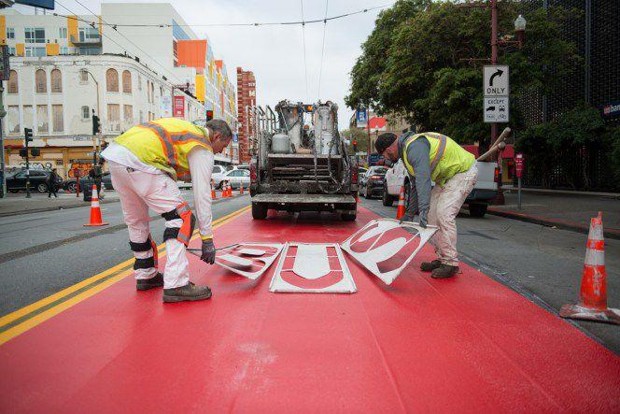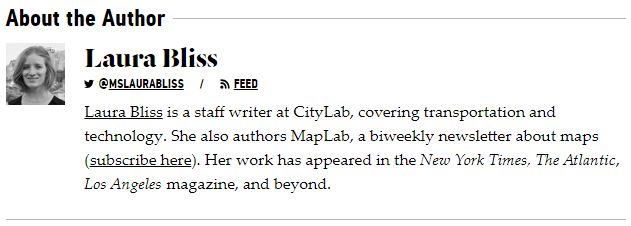To Build a Better Bus Lane, Just Paint It
| |
|||
| แหล่งที่มา : www.citylab.com | วันที่โพสต์ : 1 มี.ค. 2562 | ||
| To Build a Better Bus Lane, Just Paint It | |||
 |
|||
“Red carpet” bus lanes can be a cheap, fast, and effective way to smooth commutes for public transit users and drivers alike.
Trains have tracks, while buses share roads. And since trains don’t have to dodge cars, avoid potholes, or slog through rush-hour congestion, they tend to arrive more reliably than their rubber-tired counterparts, which are slow, late, and unpredictable in many U.S. cities largely (though not solely) due to other vehicles. That’s why city leaders looking to pull commuters out of their cars and onto public transit should put the bus first and apologize later, urges a new report from UCLA’s Institute of Transportation Studies. The name of the game is “tactical transit lanes”—also known as dedicated bus lanes. The report serves as a how-to guide for whipping up bus-only infrastructure on the cheap, and reaping outsize benefits. |
|||
|
“TTLs” are a pretty recent phenomenon. John Gahbauer and Juan Matute, the UCLA transportation scholars who authored the guide, found 17 examples in cities around the U.S.—including Boston, Denver, Seattle, L.A., and San Francisco, among others—all of which were installed after 2013, and mostly after 2016. “TTL” bus lanes are distinct from bus rapid transit (BRT), which is the form that long corridors dedicated to bus travel traditionally takes. Based on interviews and surveys of dozens of city planners, they found that TTLs are often much shorter than BRT—less than a mile long, in many cases—and targeted to dense commuter corridors rather than being spread across entire regions. They are also a lot easier to install than BRT lines, which typically require physical lane separations and fancy stations. To make a TTL, a can of paint or a stack of cones is often all that’s required to (mostly) keep cars out. And while TTLs can be permanent installations, the guide emphasizes the advantages of piloting them first, or even piloting them indefinitely, in order to diffuse the political stakes. After all, the reason that more buses don’t have their own lanes has little to do with engineering. Setting up a special space for buses usually means taking it away from private vehicles and parking spots, and people literally get murdered for that. Less extreme, car commuters and their elected officials—a group that sometimes includes the very decision-makers who may ultimately decide the fate of a bus-lane proposal—often fiercely resist projects that threaten their existing vehicle space. Which is why small-scale pilots can be useful. “They’re a great way to demonstrate the value of transit priority and engage those who benefit most—transit riders,” Matute said in an email. |
|||
 Workers make a bus lane permanent in San Francisco. (SFMTA) |
|||
| Take it from Everett, Massachusetts, which borders Boston but lacks a rail transit connection. A study of Everett’s transportation gaps identified an opportunity to ramp up bus frequency down Broadway, a major artery, and Everett’s mayor urged local planners to seize it. Compared to other suggestions in the study, like building rail or BRT, installing a bus lane would be relatively cheap and easy. First, planners had to figure out how many extra buses could run down the street during rush hour if they had their own lane. |
|||
| Corridors with “red carpets” for buses saw 24 percent fewer crashes. | |||
| But instead of starting with a plan on paper, city officials just went out one week in December and stuck cones along a one-mile stretch of Broadway. It was an unorthodox approach; they skipped the traditional process of community outreach with a paper plan in advance. If it didn’t work out, they’d just take the cones back. But the benefits were immediately noticeable: Bus trip times were cut by more than 20 percent at peak hours, and drivers shaved a few minutes off of their commutes, too. During the seven-day trial, the city gathered feedback from fans and critics alike, enough to decide to formalize the bus lane with a coat of red paint and added service. “The pilot was the process,” Everett city planner Jay Monty told UCLA. That sort of approach wouldn’t fly in all cities, “but it can in certain places,” Matute said. Not long after, Boston and Arlington, Massachusetts, ran similar cone pilots. And Everett is making other street improvements, inspired by its own success. Other cities that have adopted TTLs on a wider scale have seen more impressive results. In San Francisco, a before-and-after study foundthat three bus lanes painted onto downtown streets in 2014 improved transit delays (despite increases in car traffic), boosted transit reliability by 25 percent, and cut collisions by 16 percent. Even better, the bus lane might have saved lives: Corridors with “red carpets” for buses saw 24 percent fewer crashes that resulted in injury, compared to citywide rates that hardly budged. It’s worth remembering that even the most cutting-edge practices in bus-lane making aren’t likely to be successful without a commitment to enforcement. Even when they’re supposed to be bus-only only during the heaviest commute hours, painted transit lanes are frequently violated by private cars, delivery vehicles, and other interlopers. Enforcement—especially the automated kind—can go a long way to stop them. City DOTs should also make sure they’ve cleared the necessary federal approvals in order to to operate TTLs and avoid pesky lawsuits. To keep the red carpet from wearing off within months, make sure to paint it on new asphalt. But according to the report, even if they’re short, cheap, and a little DIY, dedicated lanes can also do a lot to smooth commutes, and brighten opinions about buses as they do. After all, it’s not just a preference for driving that keeps people off public coaches; buses get a bad rap, in some cases prejudiced, in some cases deserved. That’s part of the reason why bus ridership is spiraling downwards in so many cities, with fewer passengers leading to worse service leading to fewer passengers. If “tactical transit” helps kick that cycle in the opposite direction, cities should don their gear. |
|||
 |
|||






